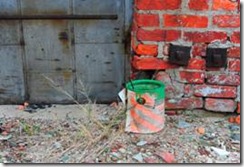My Impact At Home

Activities in our homes can contribute to water pollution. Cleaning products,
paint, medicine, and trash can make their way downstream to our lakes and
streams if we aren’t careful in how we use and dispose of these products. There
are small changes that you can make to help:
Cleaning Products
Never dispose of cleaning products in the sink drain or storm drain! For
disposal, look for household hazardous waste drop-off locations in your area.
Try non-toxic, non-hazardous cleaning products or alternative cleaning supplies
that you can make from simple household items like baking soda, vinegar and
lemon juice. Many alternative cleaning product recipes use supplies already in
your kitchen closet.
Painting
Never clean paint brushes in an area where paint can
flow into the street, storm drain or stream. For unused paint, try donating it
to a home reuse center. Dry any empty paint cans before disposal in the
trash.
Pharmaceuticals and Personal Care Products
In recent years, the Environmental Protection Agency
has found pharmaceuticals and personal care products (PPCPs) such as medicines,
shampoos, cosmetics, sunscreen and vitamins in treated wastewater, streams and
lakes. At this time, further studies and solutions to address this issue are in
the early phases. To dispose of unused PPCPs, follow the product label.
Alternatively, deposit at a household hazardous waste collection or place in a
dry plastic bag and into the garbage.
Garbage Disposal and
Recycling
Recycling conserves landfill space,
natural resources and energy. Take the time to understand what products your
local recycling center or pick-up program will take. Your participation in
recycling today will help support an event greater market for recycled products
tomorrow.
Home Remodeling
If possible, reuse or donate home items that you
are removing. Keep all construction debris away from gutters and storm
drains.
My Impact in the Yard

The chemicals, garbage, and debris from our yards
and gardens can impact water quality. These pollutants can impact aquatic life,
raise water temperature, and can disrupt the natural balance of aquatic
ecosystems. But if we put only stormwater in the drain, and follow these simple
steps, we can all do our part to improve water quality.
A. Cutting the grass:
Do not blow leaves into stormwater infrastructure, including streams, catch
basins, swales, and ditches.
B. Leaf management:
- Do not place leaves in catch basins and drainage ways.
- Participate in community leaf pick-up events.
C. Fertilizers/Pesticides use and disposal
- Do not fertilize your lawn prior to heavy rains.
- Contact your local cooperative extension office to have your soil tested to
determine the appropriate fertilizer for your soil and the type of grass in your
yard.
- Follow instructions on the labels for fertilizers and pesticides.
- For pesticides, try alternative methods.
D. Car washing:
Instead of washing the car in your driveway, consider washing your car at a
commercial car wash. Commercial car washes do not drain to the storm sewers
untreated.
E. Gardening:
- Limit the use of chemicals and fertilizers.
- Follow the instructions on the labels for the application and disposal of
fertilizers and pesticides.
F. Pet waste management: Pet waste contributes to water
pollution. In order to prevent pet waste from entering waterways:
- Scoop the poop,
- Bag it, and
- Place it in the trash.
G. Clear storm drains:
In order to reduce flooding and improve water quality, it is important to
keep storm drains clear. Debris, either from litter or yard waste, can clog
storm drains which can lead to flooding. H. Power washing: Wash water from power
washing can contain oil, grease, chemicals, dirt, detergents and other
pollutants that can pollute our streams, rivers, lakes. Best Management
Practices (BMPs) to consider are:
- Dry Clean-up methods
- Mops, brooms, rags, wire brushes etc. to clean surfaces.
- Vacuum to remove loose debris before applying water.
- If you are going to use a power washer, block storm drains with an
impervious barrier that does not cause flooding or impact safety.
- Never dispose of wash water into the street or stormwater drainage including
drains, ditches, and streams.
- Wash vehicles and equipment at commercial car washes or over grassy or
gravel areas that the wash water can seep into the ground.
- Use nozzles that minimize the amount of water that is used during power
washing.
- Try non-phosphate detergents.
- Do not wash equipment or vehicles when is it likely to rain.
H. Rain gardens:
A rain garden is a shallow depression that is planted
with native vegetation. A rain garden is designed to capture run off from roofs,
driveways, parking lots etc. with the goal of reducing runoff from the property
and pollutants entering our storm systems. Rain gardens can absorb hundreds of
gallons of rain therefore reducing the amount of stormwater leaving a property.
J. Rain barrels: Why use a rain barrel? The average rainfall of one inch within
a 24 hour period can produce more than 700 gallons of water that runs off of the
roof of an average house. A rain barrel collects water and stores it for those
times that you need it the most, during the dry months. Not only do you save
money on your water bill, but you also improving the quality of life in our
neighborhoods. Generally, a rain barrel is made from a 55-gallon drum with a
hose and screens to prevent debris from entering the barrel. A rain barrel will
reduce the amount of stormwater run off from a property and therefore can reduce
the amount of pollutants carried to our waterways. Examples of rain barrels can
be found at the following two websites:
Louisville MSD Rain Barrel program and
Lily Raintainers.
I. Watering our yards:
- Do not over water our yards.
- Use rain barrels to collect water and use the water during dry weather.
J. Septic System Maintenance:
Septic systems that are not maintained can contribute to water pollution.
Therefore, following these easy steps can benefit you and your neighbors:
- Pump and inspect your septic tank often. Pumping frequency will depend on
the size of the tank and the number of people using the system. For example, a
1000-gallon tank, serving a family of four, will typically require pumping every
two to three (2-3) years.
- Conserve water and fix all plumbing leaks that can overload the septic
system.
- Limit the use of your garbage disposal. Consider composting as an
alternative.
- Limit the use of household chemicals that can have harmful effects on the
bacteria that enables the septic system to properly process human waste.
- Do not plant deep-rooted trees on or around the location of the septic tank.
- Do not pour kitchen grease down your drain.
- Do not flush cigarette butts, sanitary napkins, or household trash down the
toilet.
- Do not drive heavy machinery over the leach field.
- Do not connect roof drains to the septic system or allow surface water to
drain into the leach field.
- Do not drain your septic tank to any nearby swale or ditch.
K. Littering
Litter and debris can clog
stormwater infrastructure resulting in flooding. Litter can also degrade water
quality. Therefore, dispose of trash, cigarettes, and other litter in garbage
cans. When appropriate recycle trash.
L. Yard Care Near Streams
For areas near streams limit the
use of pesticides and leave a riparian area. Do not blow clippings and debris in
the waterway as this can harm aquatic life and cause blockages in the stream
increasing the likelihood of flooding. Riparian areas can also reduce
erosion.
M. Pervious pavement
- Pervious pavements are a recognized runoff-reducing substitute for normal
pavements in development or redevelopment of:
- Driveways;
- Parking lots;
- Sidewalks;
- Patios, etc.
- The use of pervious pavement has been found to:
- Reduce stormwater runoff;
- Reduce flooding;
- Require less land to be set aside and less cost for the development of
detention/retention basins;
- Reduce pollutants in runoff; and
- Reduce thermal pollution.
- Always check your community’s building codes to see that pervious pavement
is allowable. Building codes are often modified to encourage developing
environmentally friendly technologies.
